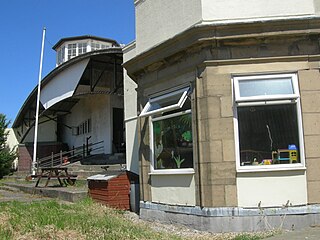
The de Havilland DH.60 Moth is a 1920s British two-seat touring and training aircraft that was developed into a series of aircraft by the de Havilland Aircraft Company.

Heston Aerodrome was an airfield located to the west of London, England, operational between 1929 and 1947. It was situated on the border of the Heston and Cranford areas of Hounslow, Middlesex. In September 1938, the British Prime Minister, Neville Chamberlain, flew from Heston to Germany three times in two weeks for talks with Adolf Hitler, and returned to Heston from the Munich Conference with the paper referred to in his later "Peace for our time" speech from 10 Downing Street.
General Aircraft Limited was a British aircraft manufacturer from its formation in 1931 to amalgamation with Blackburn Aircraft in 1949 to become Blackburn and General. Its main products were military gliders and light transport aircraft.
The Lancashire Aero Club is the oldest established flying club in the United Kingdom, it was founded in 1909 to organise the Blackpool Aviation Week, Britain's first officially recognised air show.

Desoutter is a British monoplane liaison aircraft manufactured by Desoutter Aircraft Company at Croydon Aerodrome, Surrey.
The Desoutter Aircraft Company was a British aircraft manufacturer based in Croydon. It was founded by Marcel Desoutter and produced aircraft during the late 1920s and the 1930s.

Alexandra Park Aerodrome was the second purpose-built aerodrome in the Manchester area in England. The site was chosen by the War Department in 1917 because of its open agricultural nature, and lay between the neighbouring districts of Fallowfield, Chorlton-cum-Hardy, Whalley Range, Withington and West Didsbury, at the junction of Princess Road and Mauldeth Road West, three miles south of Manchester's city centre: the land was owned by the Egerton Estate. The aerodrome's brief existence is commemorated on a plaque in the sports pavilion at Hough End Playing Fields, which now occupy part of the site. A commemorative plaque was unveiled on 7 July 2007 to mark the 90th anniversary of the aerodrome and is located in the grounds of No. 184 Squadron, Air Cadets, in Hough End Crescent.
.... André Marcel Desoutter was an English aviator, who lost a leg in an early flying accident, but went on to a successful career in the aviation industry.

Stanley Park Aerodrome was an airfield located in the Stanley Park area of Blackpool, Lancashire, England. It was also known as Blackpool Municipal Airport, and was in use for civil and military flying from 1929 until closure of the airfield in 1947. The site is now used by Blackpool Zoo.
Lympne Airport was a military and later civil airfield, at Lympne, Kent, United Kingdom, which operated from 1916 to 1984. During the First World War RFC Lympne was originally an acceptance point for aircraft being delivered to, and returning from, France but was later designated as a First Class Landing Ground, RAF Lympne. It became a civil airfield in 1919 and saw the operation of early air mail services after the 1918 armistice. It was one of the first four airfields in the United Kingdom with customs facilities.

London Air Park, also known as Hanworth Air Park, was a grass airfield in the grounds of Hanworth Park House, operational 1917–1919 and 1929–1947. It was on the southeastern edge of Feltham, now part of the London Borough of Hounslow. In the 1930s, it was best known as a centre for private flying, society events, visits by the Graf Zeppelin airship, and for aircraft manufacture by the Whitehead Aircraft Company during World War I and General Aircraft Limited (GAL) 1934–1949; in total over 1,650 aircraft were built here.

Penshurst Airfield was an airfield in operation between 1916–36 and 1940–46. Initially a military airfield, after the First World War it was used as an alternate destination to Croydon Airport, with some civil flying taking place. The airfield closed following the crash of a Flying Flea at an air display in 1936, and was converted to a polo ground.
Marden Airfield was an airfield in Marden, Kent, United Kingdom. It was operation from 1917 to 1935. Initially a Royal Flying Corps airfield during the First World War it was used post-war as an Emergency Landing Strip, RAF Marden by the Royal Air Force. It was also known as Pagehurst Emergency Landing Ground. Later serving as a civil Emergency Landing Ground, the airfield closed in 1935. The site housed a Royal Air Force transmitter station during the Second World War.

Charles Douglas Barnard was a British pilot, who took part in 1920s air races and record-breaking flights.

Bekesbourne Aerodrome was an airport located at the southeast edge of the village of Bekesbourne, southeast of Canterbury, Kent. It operated from 1916 until 1940, and had both military and civil roles.

Headcorn Aerodrome is a private airfield in Kent, England. The airfield is located 8 NM south of Maidstone; about 32 miles (51 km) southeast of London.
Haldon Aerodrome was the first airfield in Devon. Established in the 1920s as a private flying field, it developed into an airport with scheduled airline service, and was used by the Navy during World War II. The airport has also been known as Teignmouth Airport, Little Haldon Airfield and, in its military days, RNAS Haldon and HMS Heron II.
Midland & Scottish Air Ferries was Scotland's first airline, operating from 1933 to 1934. It is particularly noted for pioneering flights to the Inner Hebrides
Cramlington Aerodrome was a military airfield established in Northumberland during the First World War. It became a civil airfield serving the Tyneside area of north-east England and operated until 1935, when it was replaced by Woolsington Airport, now known as Newcastle International Airport.

Winifred Sawley Brown was an English sportswoman, aviator and author. She was the first woman to win the King's Cup air race. The race has been running annually since 1922.















